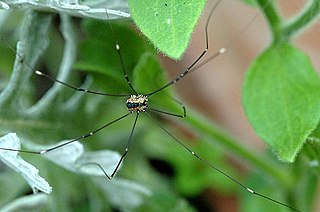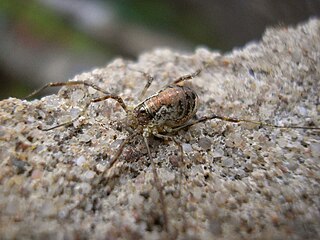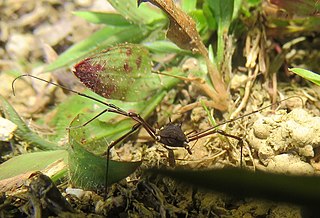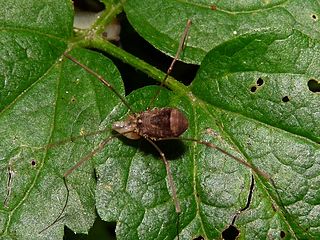
Arachnids are arthropods in the class Arachnida of the subphylum Chelicerata. Arachnida includes, among others, spiders, scorpions, ticks, mites, pseudoscorpions, harvestmen, camel spiders, whip spiders and vinegaroons.

The Opiliones are an order of arachnids colloquially known as harvestmen, harvesters, harvest spiders, or daddy longlegs. As of April 2017, over 6,650 species of harvestmen have been discovered worldwide, although the total number of extant species may exceed 10,000. The order Opiliones includes five suborders: Cyphophthalmi, Eupnoi, Dyspnoi, Laniatores, and Tetrophthalmi, which were named in 2014.

The chelicerae are the mouthparts of the subphylum Chelicerata, an arthropod group that includes arachnids, horseshoe crabs, and sea spiders. Commonly referred to as "jaws", chelicerae may be shaped as either articulated fangs, or as a type of pincers. Some chelicerae, such as those found on nearly all spiders, are hollow and contain venom glands, used to inject venom into prey or a perceived threat. Both pseudoscorpions and harvestmen have additional structures on their chelicerae that are used for grooming. In Paratrechalea, males and females have shown to have a chelicerae dimorphism, because the chelicerae is used as a mating signal for females.

The Pholcidae are a family of araneomorph spiders. The family contains more than 1,800 individual species of pholcids, including those commonly known as cellar spider, daddy long-legs spider, carpenter spider, daddy long-legger, vibrating spider, gyrating spider, long daddy, and skull spider. The family, first described by Carl Ludwig Koch in 1850, is divided into 94 genera.

Cyphophthalmi is a suborder of harvestmen, colloquially known as mite harvestmen. Cyphophthalmi comprises 36 genera, and more than two hundred described species. The six families are currently grouped into three infraorders: the Boreophthalmi, Scopulophthalmi, and Sternophthalmi.

Rilaena triangularis is a species of the harvestman family Phalangiidae. It is sometimes considered to be in the genus Paraplatybunus, in the subfamily Platybuninae.

Mitopus morio is a species of harvestman arachnid belonging to the family Phalangiidae.

Leiobunum rotundum is a species of harvestman that is found within the western portion of the Old World.

Paroligolophus agrestis is a species of harvestman. It occurs in Europe, including the United Kingdom, and has been introduced to North America in the Pacific Northwest and Nova Scotia.

Phalangium opilio is a species of harvestman belonging to the family Phalangiidae.
An ozophore is an elevated cone present in the harvestman suborder Cyphophthalmi. It carries the openings, called ozopores, of the defensive glands that are present in many harvestmen.

An ozopore is the opening of a defensive gland present in some arthropods, notably in millipedes of the order Polydesmida and in harvestmen, the eight-legged arachnids also known as "daddy long-legs". The glands themselves are known as ozadenes, also called "scent glands", "repugnatorial glands", "odoriferous glands" or "stink glands" by various authors. The name is derived from Ancient Greek ozo "smell" and Latin porus "pore, small opening".

Trogulidae is a family of harvestmen comprising 65 extant species in five genera.

Opiliones are an order of arachnids and share many common characteristics with other arachnids. However, several differences separate harvestmen from other arachnid orders such as spiders. The bodies of opiliones are divided into two tagmata : the abdomen (opisthosoma) and the cephalothorax (prosoma). Unlike spiders, the juncture between the abdomen and cephalothorax is often poorly defined. Harvestmen have chelicerae, pedipalps and four pairs of legs. Harvestmen were traditionally thought to have two eyes, except in the case of eyeless species. Developmental genetic work has shown that living species retain up to six eyes, including one pair of rudimentary median eyes and one pair of rudimentary lateral eyes.

Quindina albomarginis is a species of Neotropical harvestman in the order Opiliones. It is found in the tropical forests of Panama.

Leiobunum blackwalli is a species of harvestman. It is found in Europe, but has been introduced to British Columbia in Canada and Seattle in the United States.

Tetrophthalmi is an extinct suborder of Opiliones that had both median and lateral eyes. First described in 2014, it is known from two extinct species. Phylogenetic analysis suggests that this eye arrangement is the ancestral condition for harvestmen, placing Tetrophthalmi and Cyphophthalmi in a basal position within Opiliones.

Theromaster brunneus is a species of armoured harvestman in the family Travuniidae. It is found in North America.

Neosiro exilis is a species of mite harvestman in the family Sironidae. It is found in North America.

Forsteropsalis photophaga, also known as the glow-worm hunter, is a species of long-legged harvestman in the family Neopilionidae. This species is endemic to New Zealand, found in North Island caves in the vicinity of Waitomo. The name "photophaga" comes from their habit of feeding on the luminescent larvae, pupae, and adults of the New Zealand glow-worm Arachnocampa luminosa.


















